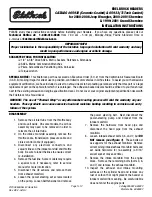
DRIVING TIPS
295
As shown in the above example, if the number of
occupants increases, the cargo and luggage load
equaling the combined weight of occupants who got
on later must be reduced. In other words, if the
increase in the number of occupants causes the
excess of the total load capacity (combined weight
of occupants plus cargo and luggage load), you have
to reduce the cargo and luggage on your vehicle.
For details about total load capacity, see “Vehicle load
CAUTION
Even if the total load of occupant’s weight and
the cargo load is less than the total load
capacity, do not apply the load unevenly. That
may cause not only damage to the tire but also
deterioration to the steering ability due to
unbalance of the vehicle, causing an accident.
Summary of Contents for ES330 2005
Page 8: ...HOW TO USE THIS MANUAL viii...
Page 9: ...PICTORIAL INDEX ix INSTRUMENT PANEL...
Page 11: ...PICTORIAL INDEX xi INSTRUMENT CLUSTER vehicles sold in U S A...
Page 13: ...PICTORIAL INDEX xiii INSTRUMENT CLUSTER vehicles sold in Canada...
Page 17: ...PICTORIAL INDEX xvii...
Page 25: ...QUICK REFERENCE 8...
Page 47: ...KEYS AND DOORS 30...
Page 69: ...SWITCHES 52...
Page 117: ...EXTERIOR EQUIPMENT 100...
Page 197: ...STEERING WHEEL AND MIRRORS 180...
Page 199: ...AIR CONDITIONING 182 AUTOMATIC AIR CONDITIONING CONTROLS...
Page 201: ...AIR CONDITIONING 184 20E395 Air flow selection...
Page 213: ...AIR CONDITIONING 196...
Page 313: ...DRIVING TIPS 296...
Page 341: ...IN CASE OF AN EMERGENCY 324...
Page 349: ...MAINTENANCE 332...
Page 359: ...INTRODUCTION 342...
Page 375: ...ENGINE 358...
Page 405: ...CHASSIS 388...
Page 408: ...ELECTRICAL COMPONENTS 391 FUSES 1 Engine compartment 64E165 2 Driver s side instrument panel...
Page 435: ...BODY 418...
















































